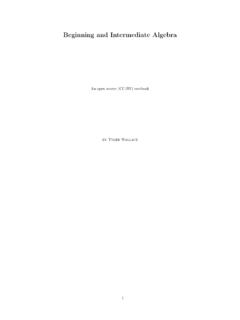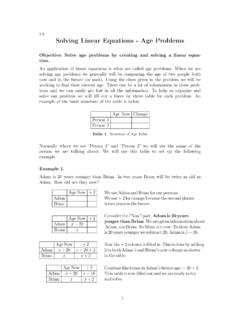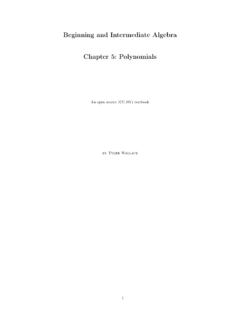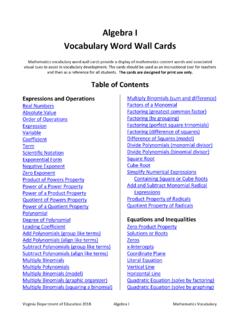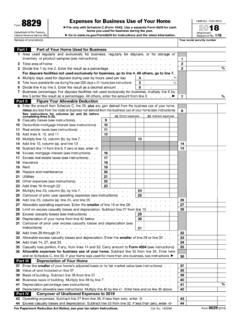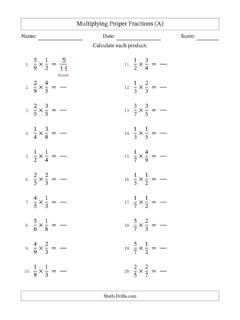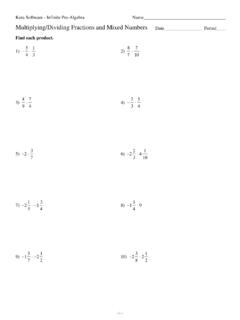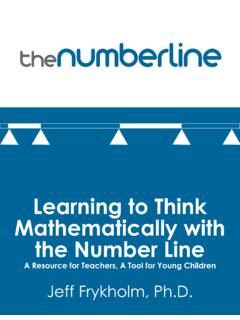Transcription of Polynomials - Multiply Special Products - CCfaculty.org
1 - Multiply Special ProductsObjective: Recognize and use Special product rules of a sum and differ-ence and perfect squares to Multiply are a few shortcuts that we can take when multiplying Polynomials . If wecan recognize them the shortcuts can help us arrive at the solution much shortcuts will also be useful to us as our study of algebra first shortcut is often called asum and a difference. A sum and a differ-ence is easily recognized as the numbers and variables are exactly the same, butthe sign in the middle is different (one sum, one difference). To illustrate theshortcut consider the following example, multiplied by thedistributing 1.
2 (a+b)(a b)Distribute(a+b)a(a+b) b(a+b)Distributeaand ba2+ab ab b2 Combine like termsab aba2 b2 Our SolutionThe important part of this example is the middle terms subtracted to than going through all this work, when we have a sum anda difference wewill jump right to our solution by squaring the first term and squaring the lastterm, putting a subtraction between them. This is illustrated in the followingexampleExample 2.(x 5)(x+ 5)Recognize sum and differencex2 25 Square both,put subtraction SolutionThis is much quicker than going through the work of multiplying and combininglike terms. Often students ask if they can just Multiply out using another methodand not learn the shortcut.
3 These shortcuts are going to be very useful when weget to factoring Polynomials , or reversing the multiplication process. For thisreason it is very important to be able to recognize these shortcuts. More examplesare shown 3.(3x+ 7)(3x 7)Recognize sum and difference9x2 49 Square both,put subtraction Solution1 Example 4.(2x 6y)(2x+ 6y)Recognize sum and difference4x2 36y2 Square both,put subtraction SolutionIt is interesting to note that while we can Multiply and get ananswer likea2 b2(with subtraction), it is impossible to Multiply real numbers and end up with aproduct such asa2+b2(with addition).Another shortcut used to Multiply is known as aperfect square.
4 These are easyto recognize as we will have a binomial with a2in the exponent. The followingexample illustrates multiplying a perfect squareExample 5.(a+b)2 Squared is same as multiplying by itself(a+b)(a+b)Distribute(a+b)a(a+b) +b(a+b)Distribute again through final parenthesisa2+ab+ab+b2 Combine like termsab+aba2+ 2ab+b2 Our SolutionThis problem also helps us find our shortcut for first term in theanswer is the square of the first term in the problem. The middle term is 2 timesthe first term times the second term. The last term is the square of the last can be shortened to square the first, twice the product, square the last. If wecan remember this shortcut we can square any binomial.
5 This is illustrated in thefollowing exampleExample 6.(x 5)2 Recognize perfect squarex2 Square the first2(x)( 5) = 10xTwice the product( 5)2=25 Square the lastx2 10x+25 Our SolutionBe very careful when we are squaring a binomial toNOTdistribute the squarethrough the parenthesis. A common error is to do the following:(x 5)2=x2 25(orx2+25). Notice both of these are missing the middle term, 10x. This iswhy it is important to use the shortcut to help us find the correct important observation is that the middle term in thesolution always hasthe same sign as the middle term in the problem. This is illustrated in the 7.(2x+ 5)2 Recognize perfect square(2x)2= 4x2 Square the first2(2x)(5) =20xTwice the product52=25 Square the last4x2+20x+25 Our SolutionExample 8.
6 (3x 7y)2 Recognize perfect square9x2 42xy+49y2 Square the first,twice the product,square the SolutionExample 9.(5a+ 9b)2 Recognize perfect square25a2+90ab+81b2 Square the first,twice the product,square the SolutionThese two formulas will be important to commit to memory. Themore familiarwe are with them, the easier factoring, or multiplying in reverse, will be. The finalexample covers both types of problems (two perfect squares,one positive, onenegative), be sure to notice the difference between the examples and how each for-mula is usedExample 10.(4x 7)(4x+ 7)(4x+ 7)2(4x 7)216x2 4916x2+56x+4916x2 56x+49 World View Note:There are also formulas for higher powers of binomials aswell, such as(a+b)3=a3+ 3a2b+ 3ab2+b3.
7 While French mathematician BlaisePascal often gets credit for working with these expansions of binomials in the 17thcentury, Chinese mathematicians had been working with themalmost 400 yearsearlier!Beginning and Intermediate Algebra by Tyler Wallace is licensed under a Creative CommonsAttribution Unported License. ( ) Practice - Multiply Special ProductsFind each )(x+ 8)(x 8)3) (1 + 3p)(1 3p)5) (1 7n)(1 + 7n)7)(5n 8)(5n+ 8)9)(4x+ 8)(4x 8)11)(4y x)(4y+x)13)(4m 8n)(4m+ 8n)15)(6x 2y)(6x+ 2y)17)(a+ 5)219)(x 8)221)(p+ 7)223)(7 5n)225)(5m 8)227)(5x+ 7y)229)(2x+ 2y)231)(5 + 2r)233)(2 + 5x)235)(4v 7) (4v+ 7)37)(n 5)(n+ 5)39)(4k+ 2)22)(a 4)(a+ 4)4)(x 3)(x+ 3)6)(8m+ 5)(8m 5)8)(2r+ 3)(2r 3)10)(b 7)(b+ 7)12)(7a+ 7b)(7a 7b)14)(3y 3x)(3y+ 3x)16)(1 + 5n)218)(v+ 4)220)(1 6n)222)(7k 7)224)(4x 5)226)(3a+ 3b)228)(4m n)230)(8x+ 5y)232)(m 7)234)(8n+ 7)(8n 7)36)(b+ 4)(b 4)38)(7x+ 7)240)(3a 8)(3a+ 8)
8 Beginning and Intermediate Algebra by Tyler Wallace is licensed under a Creative CommonsAttribution Unported License. ( ) to Multiply Special Products1)x2 642)a2 163)1 9p24)x2 95)1 49n26) 64m2 257) 25n2 648)4r2 99) 16x2 6410)b2 4911) 16y2 x212) 49a2 49b213) 16m2 64n214)9y2 9x215) 36x2 4y216)1 +10n+25n217)a2+10a+2518)v2+ 8v+1619)x2 16x+6420)1 12n+36n221)p2+14p+4922) 49k2 98k+4923) 49 70n+25n224) 16x2 40x+2525) 25m2 80m+6426)9a2+18ab+ 9b227) 25x2+70xy+49y228) 16m2 8mn+n229)4x2+ 8xy+ 4y230) 64x2+80xy+25y231) 25+20r+ 4r232)m2 14m+4933)4 +20x+25x234) 64n2 4935) 16v2 4936)b2 1637)n2 2538) 49x2+98x+4939) 16k2+16k+ 440)9a2 64 Beginning and Intermediate Algebra by Tyler Wallace is licensed under a Creative CommonsAttribution Unported License.
9 ( )5
